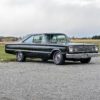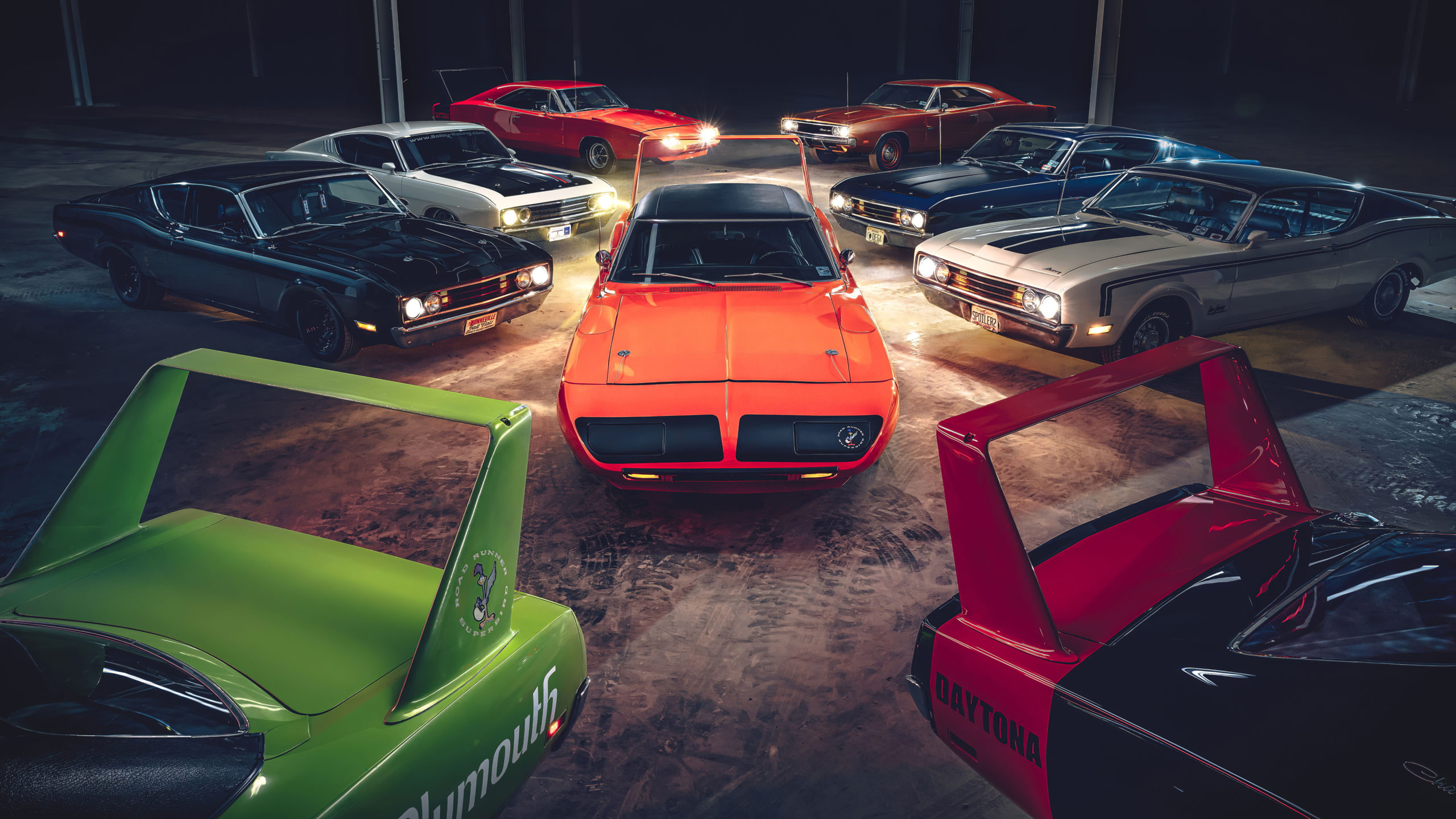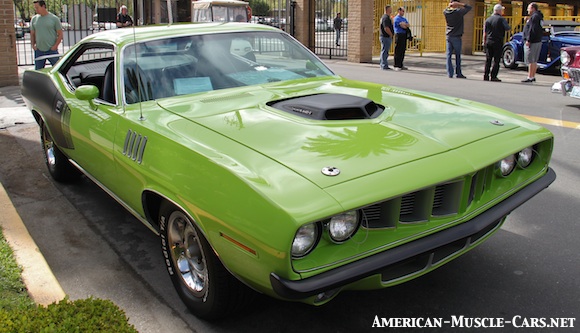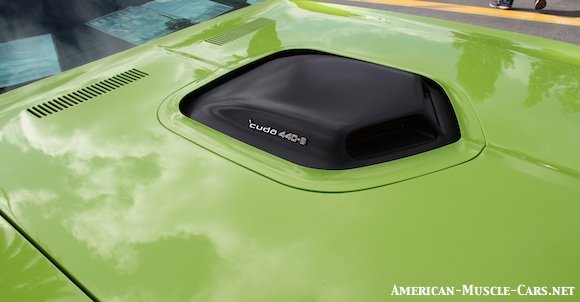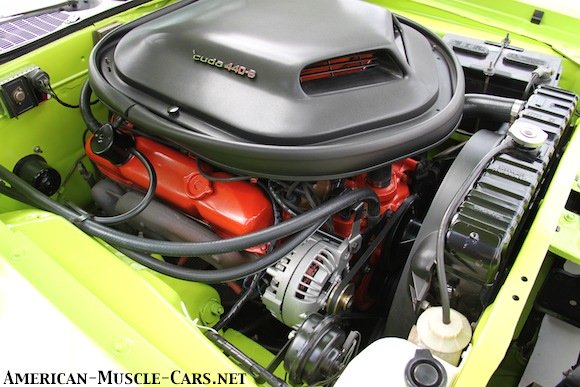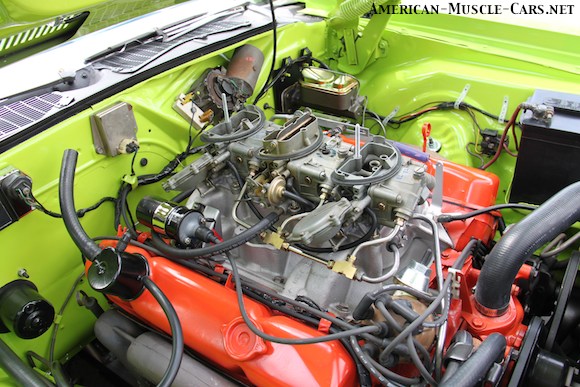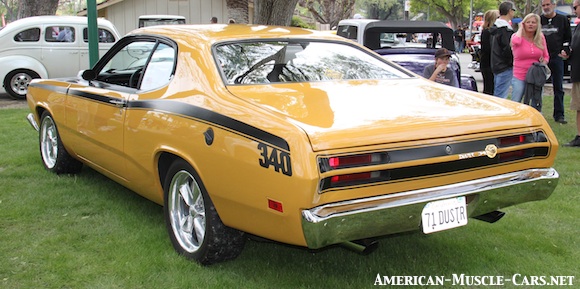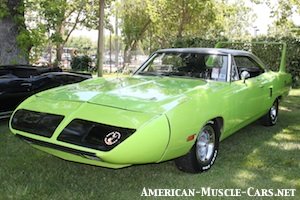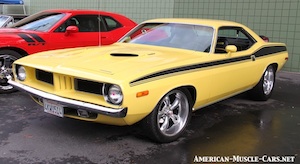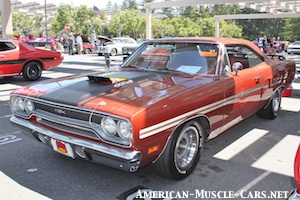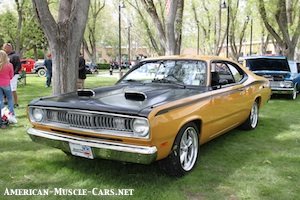Plymouth Muscle Cars

ABOVE: One of the last of the Plymouth Muscle Cars, this ’73 Cuda was one of the best-looking cars of the era.
PLYMOUTH MUSCLE CARS
MOPAR’S BARGAIN-BRAND
Despite some seriously powerful and cool cars from the 1950s, some with Hemi power, the Plymouth brand was considered to be on the lowest run of the ladder of Chrysler brands. At the top was Imperial (at one time broken off from the Chrysler line and made it’s own stand-alone brand) and Chrysler, which filled the luxury segment nicely, competing against Lincoln and Cadillac. Dodge was Chrysler’s mainstream brand, it’s high-volume, mass-market division, meant to do battle with GM’s mass-market division, Chevrolet, and Fomoco’s Ford. Then, there was Plymouth, cast in the role of the bargain Chrysler brand. Most Plymouths were just Dodges with all the equipment pulled out, a cheap interior and smaller engines. And it worked. In fact, it was a very effective mix of brands, with all ends of the market fairly well covered. So well in fact that when Chrysler finally retired the Plymouth brand in 2001, it was the 11th best-selling brand in the world!! And they killed it? Chrysler was in the care of Mercedes at the time, and it’s just one more example of how they screwed things up.
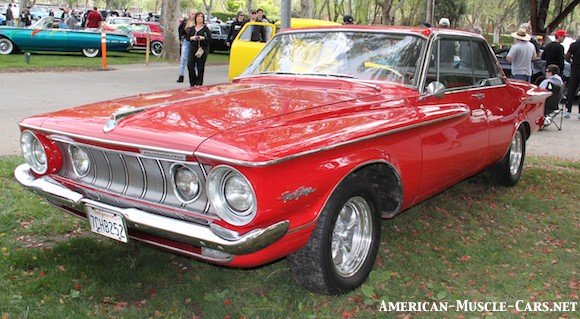
ABOVE: The ’65 Sport Fury above was typical of Plymouth Muscle Cars in the early 60s. Not much style, but loads of power. Mopar in general didn’t have a lot of good-looking designs back then. But they would cram a huge engine in, maybe a 413 or a 426 Max Wedge, and they were deemed muscle cars.
BELOW: The 1968 Plymouth Barracuda certainly wasn’t much to look at, showing its humble roots in the Plymouth Valiant. This one happens to be a convertible, but most were fastbacks.
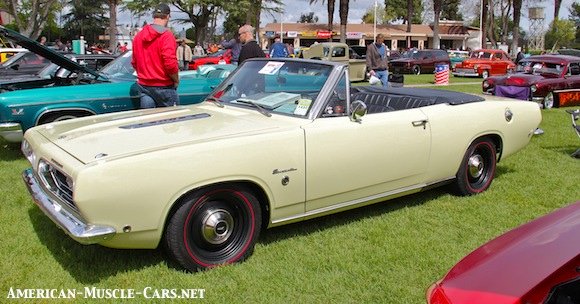
PLYMOUTH MUSCLE CARS
CAUGHT FLAT-FOOTED
The 3 Mopar brands were just putting right along in the early 1960s, again adapting fairly quickly to strategic changes in the marketplace, like the move toward smaller cars. In the mid-1950s, small cars were are rare as hen’s teeth, and considered to be just as odd. About the only American small car was the Nash Metro, and it was rather odd. But then about 1959, things started to change. Ford introduced its compact sized Falcon, then Chevrolet soon followed with the Chevy II. Chrysler wasn’t far behind with Dodge’s Dart and it’s Plymouth clone, the Valiant. But times were a changing, and the “youth market” was starting to gain steam. Then 1964 hit, and all hell broke loose! Ford introduced the Ford Mustang to a stunned public, kicking off the Pony Car Wars, followed by the Pontiac GTO, firing the first volley of the Muscle Car Wars. One GM division after another sprouted big-engined, mid-sized muscle cars, and an eager public snapped them up. Chevy made Chevelles into SS’s, Oldsmobile turned the Cutlass into the 442, Ford hopped up its Falcon and Fairlanes and the race was on. Chrysler had to do something quick, and use the cars it already had, as they never had the kind of budget that the other 2 Detroit giants had. So, Plymouth took their lowly compact Valiant, grafted on a truly hideous (in my humble opinion) fastback rear end with one of the biggest back windows in captivity, and called it the Plymouth Barracuda, perhaps one of the first Plymouth Muscle Cars.

1968 Plymouth Road Runner, basically a tarted-up Plymouth Belvedere with a big engine. This one has a 383 Magnum.
PLYMOUTH MUSCLE CARS
SUCCESS BREEDS SUCCESS
The little Barracuda was so popular that it was decided to increase the number of Plymouth muscle cars. So, next up was the midsize Plymouth Belvedere. It got the full treatment with unique styling cues, bigger wheels and tires, and of course the choice of some truly monstrous engines. These cars sold quite well, and garnered quite a reputation among hard-core car nuts as being fast, rugged, and well-built. Engineering had always been a stalwart of the Chrysler brand, but styling not so much. While these Plymouth muscle cars were popular enough, they were always a bit out of touch, styling-wise, with sleek muscle cars like the Chevrolet Chevelle SS, Pontiac GTO, and they had nothing like the sexy Pony Cars, the Ford Mustang, Chevrolet Camaro and Pontiac Firebird. Mopar did their best to make up the it with wild color schemes, crazy gimmicks like huge pistol grip shifters that looked like some mediaeval weapon, or cartoon horns that went “Meep Meep”, and of course wickedly power engines, like the 383 Magnum, 440 Magnum, 426 Max Wedge, and the king of the hill, the 426 Hemi (nicknamed “the Elephant Motor”). The Plymouth Road Runner was probably one of the lowest-price muscle cars on the market in 1968 that could produce the big horsepower. Stripped to the bone to get the price down from their sister-car, the Dodge SuperBee, with very little sound deadening they were nothing more than a hollow steel box with a massive engine in them, and they sounded like it when you hit the gas. But what fun! This was really the golden age for Plymouth Muscle Cars, along with everyone else in the classic American Muscle Car Era. And like everyone else, it really peaked in 1970, with Plymouth’s own personal peak having to be the snarky Plymouth Superbird, the hottest of all Plymouth muscle cars, with its protruding aero nose and massive rear wing, added to lower drag for NASCAR racing. They had to be homologate to be raced, so there was a street version, often with the 440 Magnum, but sometimes with the ground-shaking 426 Hemi. These cars today are among the most valuable, most sought after of not only all Plymouth Muscle Cars, but classic American Muscle Cars in general.
This ’71 Cuda has a 440 Six-Pack and a garish optional graphics package.
PLYMOUTH MUSCLE CARS
THE MUSCLE CAR BOOM DRAWS TO A CLOSE
After 7 solid years without a Pony Car to compete in the Pony Car Wars started by the 1964 Ford Mustang, and followed in 1967 by the Chevrolet Camaro and Pontiac Firebird twins, then followed again by the 1968 AMC Javelin, Chrysler was finally ready to introduce its very own set of Pony Car twins: the 1970 Dodge Challenger and the 1970 Plymouth Barracuda. Both were absolutely gorgeous, and were probably the best Pony Cars on the market at the time, offering better performance and more interior and trunk space that their competition. Alas it was just a little too late, as 1970 was the peak of the Classic American Muscle Car Era, and from here on out, horsepower, performance and even looks would decline drastically, due to increasing insurance rates, rising fuel prices, new safety requirements, and new smog laws. For this reason, the 1970 Plymouth Barracuda is generally considered to be the most desirable, as it has the best engine options. Each year, until the model was dropped after the 1973 model year, engines grew smaller and less powerful, choked down by new smog systems, lower compression to deal with unleaded gas, and for the first time mandates on improved fuel economy. Around this time, the American auto industry adapted, quite ably actually, to not only increased government intervention, but also changing market demographics. This same “youth market” that bought all the stop light dragsters in the 1960s were now a little older and more settled down, and they were now ready for a whole new crop of “personal luxury cars”. Good bye Plymouth Muscle Cars. The good news is that they are still alive and well today, and just as popular as ever. You can find them at classic car shows, classic car auctions and in classic car clubs.
Plymouth Muscle Car ENGINES
PLYMOUTH MUSCLE CARS – THE SIX-PACK
Mopar (Chrysler) built lots of badass engines, most very big, and always sturdy and well-engineered. As the Muscle Car Era heated up, Mopar engines got bigger and even more powerful. By 1967, everyone else in the American Muscle Car arena had abandoned triple carburetion, which pretty much meant GM. They had a triple 2-barrel carb setup that they had dubbed “Tri-Power”, used for both the 427 Corvette and the Pontiac GTO. By the 1968 model year, both cars were running only single 4-barrel carburetors across the board. But, not Chrysler, no sir. About the same time everyone else was giving it up, Chrysler picked up the triple-carb ball and ran with it. Dubbing their system “Six-Pack” was typically Mopar, as they marketing department always seemed to come up with the most outlandish names for things. Above, you can see a 440 Six-Pack system with it’s 3 Holley 2-barrel carburetors all in a row. They came with “Shaker” hood scoops, meaning the hood scoop was mounted to the engine itself, and protruded through a hole in the hood. Since it sat on top of the engine, the hood scoop shook with the engine’s vibrations and torque, hence the name.
PLYMOUTH MUSCLE CARS GET TAMER
As the Muscle Car Era drew to a close, having peaked in 1970, compression and horsepower was on the retreat. Big block 440s and 383s, and the big 426 Hemi were soon to be relegated to the junkpile of history, replaced by small block 318s, 340s and 360s. And with them, came a whole new kind of Plymouth Muscle Car, the Plymouth Duster. Light, simple, agile, and pretty fast even with the 340 small block, they sold well and remain popular to this day. Above is a 1971 Plymouth Duster with 340 V8.

PLYMOUTH MUSCLE CARS TURN INTO PERSONAL LUXURY CARS
This 1972 Roadrunner shows the direction former muscle cars were going, in the early 1970s. With gas prices on the rise, smog and safety laws were emasculating muscle cars, and the ‘youth market’ (read that: Baby Boomers) aging as they were, the market was shifting away from performance and toward personal luxury. Cars like the Chevy Monte Carlo, Pontiac Grand Prix and the Ford Thunderbird typified this new class of car. The Roadrunner, while still very sporty, ceased to be a fire-breathing street-fighter, grew bigger, heavier, slower and softened up a bit.
Plymouth Muscle Cars MODEL-BY-MODEL
It started out as a lowly Belvedere. But after shoe-horning in a 383 cubic-inch big block, heavy duty suspension and a cool appearance package, it becomes the “Roadrunner”. Complete with Warner Brothers cartoon characters (for which Chrysler paid royalties) and the distinctive “Meep, Meep” horn (what did I tell you about those crazy Mopar marketing types?)
When the boxy aerodynamics of the Roadrunner became a problem on the NASCAR track, Plymouth grafted on a slippery new nose & huge rear wing, creating a winner & an instant classic! A few were sold to the public for homologation.
It was a long time coming. The Barracuda had humble beginnings in its first 2 generations. It wasn’t until 1970, just at the Muscle Car Era was peaking, that Mopar finally came out with a proper Pony Car, the Cuda, and it’s sister-car, the Dodge Challenger.
Loaded with big block power and all kinds of attitude, the GTX became a legend, and built a loyal following that remains to this day.
Smaller & lighter than muscle cars of yore, the new Duster was the perfect 70s muscle car. No more big blocks, only small block 318s, 340s and 360s. The Duster was actually a pretty good car and sold quite well.


